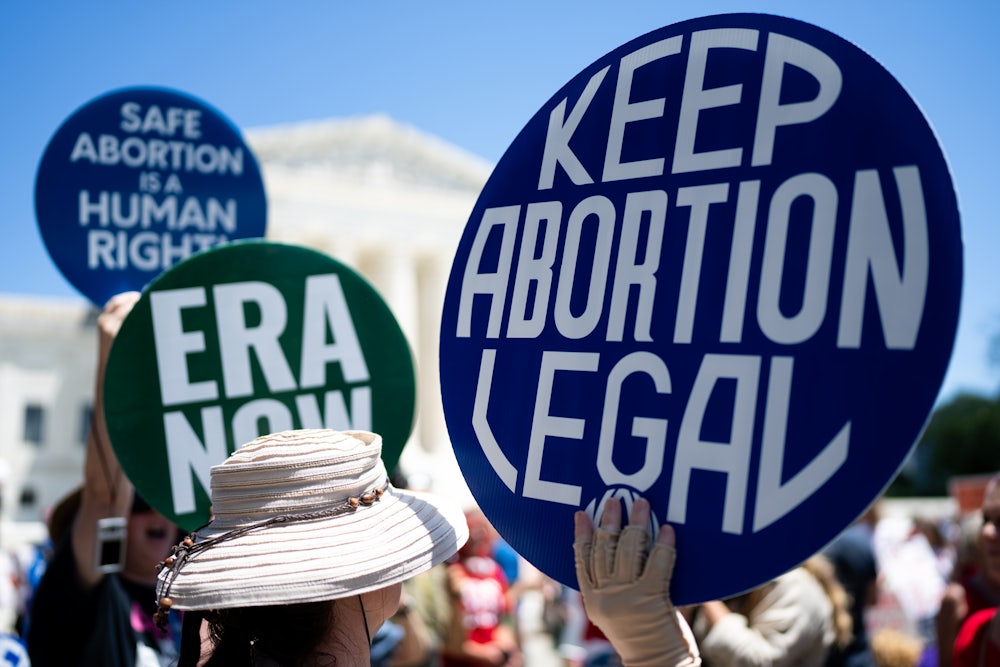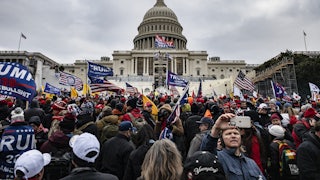At first glance, the new campaign Abortion Access Now doesn’t look that new—its website features the ubiquitous, navy-blue “Keep Abortion Legal” protest sign from the National Organization for Women (who are not part of the campaign). Its remit doesn’t seem all that new, either; the “national, 10-year campaign,” Politico reported this week, “will both prepare policies for the next time Democrats control the House, Senate and White House, and build support for those policies among lawmakers and the public.” But the policies that have been shared so far are legislative proposals that have already been made. The headline is the money: The groups involved in the campaign—including well-known and well-resourced groups such as Planned Parenthood and the ACLU—recently announced they are “pledging a $100 million investment.”
The high ticket price, along with the apparent lack of anything resembling a new plan, or a plan at all, has raised some questions. If this is going to be “Roe 2.0,” as Medical Students for Choice executive director Pamela Merritt put it to Politico, that’s already making a concession, one that will codify barriers to abortion access. “I will never understand leading with compromise, because that’s a sign of weakness that we should not be showing,” said Merritt. (The group was not invited to join the campaign.) This campaign announcement also comes on the second anniversary of the Dobbs decision, which feels fairly late in the game—particularly for statements like “We’re not going to let them out-prepare us,” as campaign member Unite for Reproductive and Gender Equity executive director Kimberly Inez McGuire is quoted as saying.
So what is the goal, exactly? Abortion Access Now, their new PSA explains, “is a bold public awareness campaign,” featuring the highest-profile national groups, such as Planned Parenthood, Reproductive Freedom for All (formerly NARAL), In Our Own Voice: National Black Women’s Reproductive Justice Agenda, the National Latina Institute for Reproductive Justice, the National Asian Pacific American Women’s Forum, and Urge for Reproductive & Gender Equity. Legal organizations ACLU, Center for Reproductive Rights, and the National Women’s Law Center round out the campaign.
Deliberately launched on the second anniversary of the Dobbs decision, the campaign positions itself as a comprehensive, systemic response to a post-Roe reality. “As millions of Americans suffer under these cruel bans and restrictions, the reproductive health, rights, and justice movements, as well as individual supporters, have been fighting like hell in courts, statehouses, and on the ballot, and helping as many people as possible jump enormous hurdles to get the care they need,” reads a June 24 post on the group’s Medium account. “But we are never going to solve this crisis through a patchwork of fixes that only mitigate harm or by flying people across the country for abortion care.”
Very sadly, this was the reality even before Roe was overturned: By 2020, clinic closures and abortion bans meant more than 80,000 people traveled that year for an abortion; later abortions were only available in a handful of states; and legal battles consumed much of the political work of reproductive health and rights’ groups. If anything marked the Roe years, it was constantly having to defend a single Supreme Court decision, while abortion access was steadily stripped away at the state level, until at last even that single decision was lost.
No one can say there was no warning. Millions of people in the United States were already living in the “crisis” now registering to those who formerly considered their rights were protected. These groups saw it coming. Some, like Planned Parenthood, even built the crisis into their identity. This creates challenges now, or it should: Why should people trust that these groups can win back what we lost when they couldn’t protect it to begin with?
One of the first fights lost following the original Roe decision was the passage of the Hyde Amendment, which went into effect in 1977 and bans the use of any federal funds for abortion. This ban fell hardest on people on Medicaid, and put real reproductive rights out of reach for poor and working-class people and people of color. Today, that includes 5.5 million women ages 15 to 49 who are covered by Medicaid and who live in states where abortion remains legal, according to a 2024 report from KFF. That’s about 35 percent of all women in that age group with Medicaid; another 21 percent of that age group live in states where abortion is illegal.
To their credit, this new campaign puts repealing the Hyde Amendment on their agenda. That’s thanks to decades of work by reproductive justice advocates pushing reproductive rights groups to make Hyde—and low-income people and people of color—a priority. The long and still unfinished fight to repeal Hyde encapsulates much of why we are where we are: The groups with the most resources and the most political influence took far too long to listen to those without. (Some of those same reproductive justice groups have signed onto Abortion Access Now; some, notably All* Above All, have apparently not.)
The Abortion Access Now campaign is at least sensitive in its messaging about the insufficiency of Roe. “We are pushing for something beyond Roe and thinking about what it means to really rebuild infrastructure around abortion care and maternal care in the United States,” Sabrina Talukder, director of the Women’s Initiative at the Center for American Progress and a member of the coalition’s steering committee, told Politico.
A vital part of that infrastructure is abortion funds, groups that not only provide direct funding to cover an abortion but also provide support navigating the myriad barriers to care, from long-distance travel to legal hurdles. Many of these abortion funds could use the kind of cash that Abortion Access Now is apparently raising: Two years after Dobbs, groups who provide practical abortion support have seen the surge in so-called “ragegiving” dry up considerably and are now struggling to stay afloat. “Abortion funds are finding ways to make reproductive justice a reality in spite of us being in a state of emergency,” said Oriaku Njoku, executive director of the National Network of Abortion Funds in a recent call. From July 2021 to June 2022, the National Network of Abortion Funds reports that its 100 member funds distributed almost $20 million in abortion funding. That sounds like a lot, and it is—particularly when only 56 percent of abortion funds have one or more full-time staffers. But it’s a world away from the big national groups who are part of the campaign. Planned Parenthood’s lobbying arm, from July 2022 to June 2023, raised more than $82 million between the national Planned Parenthood Action Fund and its affiliated local 501(c)4 organizations. How the new $100 million pledged would increase direct funding for abortion—or if it would increase funding for abortion at all—remains to be seen.
No abortion funds—the groups who are closest to the reality of access and lack thereof—are listed as members of the Abortion Access Now campaign. Neither are independent clinics, like Partners in Abortion Care, one of the only clinics offering abortion at all trimesters. “Almost all the folks doing the on-the-ground work in our communities have been excluded,” said Partners co-founder and ob-gyn Diane Horvath, after the campaign announcement. “That should tell you everything you need to know.”
Given all of this, seeing so many resources directed to a campaign with few details to offer feels like just another repeat of past mistakes. Anti-abortion groups have scarily detailed plans for the state of reproductive coercion they imagine ruling, whether that’s Project 2025 and its “instruction manual” for Trump, or their commitment to using the courts and state legislatures to redefine medication abortion as fundamentally dangerous. Meanwhile, some of the same groups leading Abortion Access Now reportedly pushed back on shield laws that would expand abortion access and slow-walked efforts to repeal the 150-year-old law anti-abortion groups are telling Trump to use as a national abortion ban.
This is not to say that reproductive freedom should be won using the same antidemocratic means as anti-abortion groups have used. It’s just that the time for caution in the face of a hostile legal system has long passed us by. Until the national groups move with real urgency, not promises two years after the fact, the millions of dollars—even a fraction—may be better spent on abortion and the groups still helping people get one.


